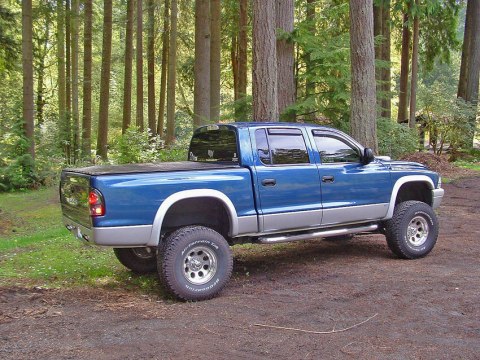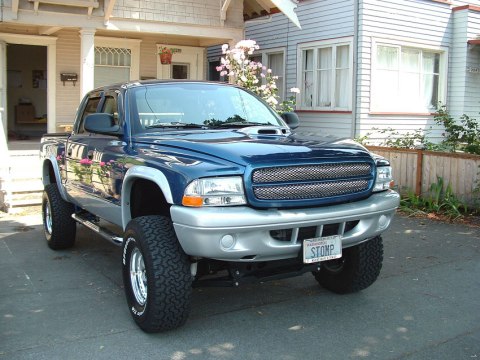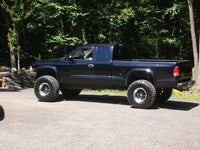The 273 (4.5 L) was the first LA engine, introduced in 1964 and offered through 1969, rated at 180 BHp. It had a 3.625 in (92 mm) bore and 3.31 in (84 mm) stroke. It had a mechanical solid lifter valvetrain until 1968 when hydraulic lifters were introduced. A special version was also available in 1966 only - it used a 0.500-inch (12.7 mm) lift solid-lifter camshaft, fabricated-steel-tube exhaust, and a Holley 4-barrel carburetor, producing 275 horsepower (1 hp/cu in). It was available in the Dodge Dart only, and the car so equipped was called the "D-Dart". A 235 hp (175 kW) version with a less aggressive camshaft and without the tube headers was available on regular production Darts, Valiants, and Barracudas from 1965 to '67, it was standard only in the Barracuda Formula S model.

2002 Dodge Dakota QuadCab 4x4

2000 Dodge Dakota Sport CC
The LA 318 was a 318 cu in (5.2 L) relative of the A 318. Like the A 318, it has a larger bore at 3.91 in (99 mm) as well as a stroke of 3.31 in (84 mm). It appeared shortly after the 273, in 1967, and proved tremendously successful. A version of this engine was available until 1991 when its was superseded by the Magnum version (See below). It used hydraulic lifters and a two barrel carburetor for most of its production, though four-barrel Carter Thermo-Quad and Rochester Quadrajet carburetors were used in police applications starting in 1978. The 318 received roller lifters and a fast-burn cylinder head in 1985. Throttle-body electronic fuel injection was factory equipment on the 1981-1983 Imperial. From 1988-1991, another throttle-body fuel injection system was used for truck and van applications.

2002 Dodge Dakota QuadCab 4x4
As the Detroit power wars heated up in the mid-1960s, Chrysler decided to produce a small block V8 specifically designed for high performance applications. The goal was to have a lightweight, high output engine equally suited for the drag strip or an oval track[citation needed]. The result of this decision was the 340 cu in V8. Chrysler's engineers increased the 318's cylinder bores to 4.04-inch (103 mm) while keeping the 318's 3.31-inch (84 mm) stroke. Anticipating higher loads resulting from racing operation, the engineers fitted a forged steel crankshaft instead of the cast nodular iron unit used in the 318. A 4-barrel carburetor was mated to a high-rise, dual plane intake manifold. This induction setup fed into a set of cylinder heads that are still considered one of the best of that era. The heads were high-flow items with big ports, and used 2.02-inch (51 mm) intake and 1.60-inch (41 mm) exhaust valves. An aggressive cam was fitted to take advantage of the much better breathing top end. 1968 4-Speed cars got an even hotter cam, but it was discontinued in 1969[citation needed]. The engine was equipped with hydraulic lifters[citation needed]. Power output was officially stated as 275 hp (205 kW) for the 4 barrel and 290 hp (216 kW) for the 6-pack version with triple 2-barrel carburetors. Using domed pistons, the 340's compression ratio was 10.5:1, placing it near the limit of what was possible on pump gasoline[citation needed]. The 340 also used heavy-duty parts such as a double-roller timing chain, windage tray and revised oil pump[citation needed].

Dodge Dakota
In 1970, Chrysler offered a special version of the 340 for use in the Challenger TA and Cuda AAR. The "TA" engine featured a heavy duty short block featuring additional webbing in block to allow for 4 bolt main bearing caps, double roller timing chain and 10.5:1 compression. The heads featured larger ports compared to a standard 340 and offset rocker arms that allowed the pushrods to be moved away from the intake ports for improved airflow. They featured an aluminium intake manifold with three two barrel Holley carburetors and a dual points ignition system.

450hp Dodge Dakota 4x4 Custom

Tuff Country 1997-1999 Dodge
Like many other performance V8's of the day, for insurance reasons, the 340 engine's power output was officially understated[citation needed]. In reality, either the 4bbl or 6bbl configuration could produce at least 315 to 320 hp (235 to 239 kW)[citation needed]. The 340 developed a reputation for outperforming much larger and heavier engines, with the attendant handling benefits provided by the relatively light-weight 340. The engine was praised as a high-revving unit with good durability, making it popular with circle-track racers[citation needed].

Dodge Dakota owners have

2000 Dodge Dakota Sport CC

1999 Dodge Dakota Sport Lifted
Due to the combination of rising gasoline prices and insurance companies' crackdown on high-performance vehicles[citation needed], the 340 did not stay in production long. It was released in 1968, detuned with lower compression (via flat-top pistons) and smaller 1.88 inch intake valves in 1972[citation needed], and was withdrawn from production after the 1973 model year.

dakota lifted with 35s

2000 Dodge Dakota
The LA 360 (5.9 L) has a 4.00 in bore and a 3.58 in stroke. It was released in 1971 with a two barrel carburetor. The 360 used the large intake port 340 heads with a smaller intake valve (1.88 inch). In 1973, a 4-barrel version was released. In 1974, the 360 became the most powerful LA engine with the end of 340 production. After 1980, the 360 was primarily used in Dodge Ram trucks and vans. However, in some instances, the 360 was used in Dodge Diplomat police cars. Edit: With the possible exception of some rumored 'special factory cars', Diplomat police cars did not receive the 360 as factory equipment, however the 360 was available in civilian-package cars. The 1978-1979 Lil' Red Express truck used a special high performance 360 4-barrel engine, with factory production code EH1 and was the fastest production vehicle in North America for those years.[citation needed]. The EH1 was a modified version of the E58 360 police engine (E58) producing 225 hp (168 kW) net @ 3800 rpm[citation needed]. Some prototypes for the EH1 featured Mopar Performance W2 heads[citation needed], although the production units had the standard 360 heads. There was also a "lean burn" version of the 360. The 360 was replaced for 2003 with the 5.7 L Hemi.

FABMaster6432\x26#39;s 1998 Dodge

1999 Dodge Dakota Sport Lifted

1999 Dodge Dakota Sport Lifted

for a 2\x26quot; lift all around.

Sweet lifted daks/durs (pics)

2002 Dodge Dakota QuadCab 4x4

2000 Dodge Dakota Sport CC
The LA 318 was a 318 cu in (5.2 L) relative of the A 318. Like the A 318, it has a larger bore at 3.91 in (99 mm) as well as a stroke of 3.31 in (84 mm). It appeared shortly after the 273, in 1967, and proved tremendously successful. A version of this engine was available until 1991 when its was superseded by the Magnum version (See below). It used hydraulic lifters and a two barrel carburetor for most of its production, though four-barrel Carter Thermo-Quad and Rochester Quadrajet carburetors were used in police applications starting in 1978. The 318 received roller lifters and a fast-burn cylinder head in 1985. Throttle-body electronic fuel injection was factory equipment on the 1981-1983 Imperial. From 1988-1991, another throttle-body fuel injection system was used for truck and van applications.

2002 Dodge Dakota QuadCab 4x4
As the Detroit power wars heated up in the mid-1960s, Chrysler decided to produce a small block V8 specifically designed for high performance applications. The goal was to have a lightweight, high output engine equally suited for the drag strip or an oval track[citation needed]. The result of this decision was the 340 cu in V8. Chrysler's engineers increased the 318's cylinder bores to 4.04-inch (103 mm) while keeping the 318's 3.31-inch (84 mm) stroke. Anticipating higher loads resulting from racing operation, the engineers fitted a forged steel crankshaft instead of the cast nodular iron unit used in the 318. A 4-barrel carburetor was mated to a high-rise, dual plane intake manifold. This induction setup fed into a set of cylinder heads that are still considered one of the best of that era. The heads were high-flow items with big ports, and used 2.02-inch (51 mm) intake and 1.60-inch (41 mm) exhaust valves. An aggressive cam was fitted to take advantage of the much better breathing top end. 1968 4-Speed cars got an even hotter cam, but it was discontinued in 1969[citation needed]. The engine was equipped with hydraulic lifters[citation needed]. Power output was officially stated as 275 hp (205 kW) for the 4 barrel and 290 hp (216 kW) for the 6-pack version with triple 2-barrel carburetors. Using domed pistons, the 340's compression ratio was 10.5:1, placing it near the limit of what was possible on pump gasoline[citation needed]. The 340 also used heavy-duty parts such as a double-roller timing chain, windage tray and revised oil pump[citation needed].

Dodge Dakota
In 1970, Chrysler offered a special version of the 340 for use in the Challenger TA and Cuda AAR. The "TA" engine featured a heavy duty short block featuring additional webbing in block to allow for 4 bolt main bearing caps, double roller timing chain and 10.5:1 compression. The heads featured larger ports compared to a standard 340 and offset rocker arms that allowed the pushrods to be moved away from the intake ports for improved airflow. They featured an aluminium intake manifold with three two barrel Holley carburetors and a dual points ignition system.
450hp Dodge Dakota 4x4 Custom

Tuff Country 1997-1999 Dodge
Like many other performance V8's of the day, for insurance reasons, the 340 engine's power output was officially understated[citation needed]. In reality, either the 4bbl or 6bbl configuration could produce at least 315 to 320 hp (235 to 239 kW)[citation needed]. The 340 developed a reputation for outperforming much larger and heavier engines, with the attendant handling benefits provided by the relatively light-weight 340. The engine was praised as a high-revving unit with good durability, making it popular with circle-track racers[citation needed].

Dodge Dakota owners have

2000 Dodge Dakota Sport CC

1999 Dodge Dakota Sport Lifted
Due to the combination of rising gasoline prices and insurance companies' crackdown on high-performance vehicles[citation needed], the 340 did not stay in production long. It was released in 1968, detuned with lower compression (via flat-top pistons) and smaller 1.88 inch intake valves in 1972[citation needed], and was withdrawn from production after the 1973 model year.

dakota lifted with 35s

2000 Dodge Dakota
The LA 360 (5.9 L) has a 4.00 in bore and a 3.58 in stroke. It was released in 1971 with a two barrel carburetor. The 360 used the large intake port 340 heads with a smaller intake valve (1.88 inch). In 1973, a 4-barrel version was released. In 1974, the 360 became the most powerful LA engine with the end of 340 production. After 1980, the 360 was primarily used in Dodge Ram trucks and vans. However, in some instances, the 360 was used in Dodge Diplomat police cars. Edit: With the possible exception of some rumored 'special factory cars', Diplomat police cars did not receive the 360 as factory equipment, however the 360 was available in civilian-package cars. The 1978-1979 Lil' Red Express truck used a special high performance 360 4-barrel engine, with factory production code EH1 and was the fastest production vehicle in North America for those years.[citation needed]. The EH1 was a modified version of the E58 360 police engine (E58) producing 225 hp (168 kW) net @ 3800 rpm[citation needed]. Some prototypes for the EH1 featured Mopar Performance W2 heads[citation needed], although the production units had the standard 360 heads. There was also a "lean burn" version of the 360. The 360 was replaced for 2003 with the 5.7 L Hemi.

FABMaster6432\x26#39;s 1998 Dodge

1999 Dodge Dakota Sport Lifted

1999 Dodge Dakota Sport Lifted

for a 2\x26quot; lift all around.

Sweet lifted daks/durs (pics)
No comments:
Post a Comment